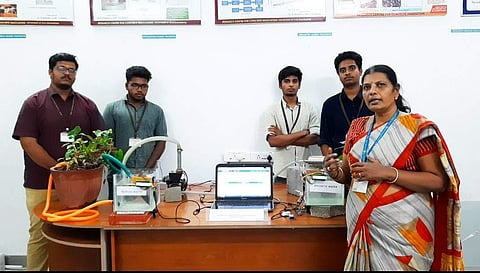

Agriculture requires large volumes of water — a resource that's increasingly becoming scarce. While several efforts have been taken to reduce water usage in agriculture, some haven't fared as well as others. But the students of Sona College of Technology in Salem have developed a magnetisation-based and IoT-powered water treatment technology that can reduce the quantity of water used for growing crops and decrease farmers' woes. The technology has earned them the top spot in the software category of Smart India Hackathon 2020.
So, how does magnetisation help reduce the quantity of water used to irrigate? Manimoliselvan C, one of the six students involved in the project, explains, "Farmers all over the country are dependant on borewells for their watering needs. However, the water in the borewells is hard and lacks the proper mineral composition required by the crops. The quality of water from the borewells is also dependant on external factors like climate." And what happens when a magnet is introduced? "When the water passes through the magnetic field, its property is altered. The molecules are broken down which causes water to be absorbed easily. The magnet also enhances the quality of water by altering the chemical composition of the minerals. Therefore, less water can be used to irrigate a larger field as compared to untreated borewell water." says the final year Civil Engineering student. The students used Permag Neodymium (N406), a rare-earth permanent magnet for their project.
Developed for over a year, the students and the faculty had originally submitted the project in the hardware category of the Smart India Hackathon. The pandemic, however, meant that they could only demonstrate their technology virtually. With the addition of IoT, the project then became an official entry in the software category, eventually winning its particular problem statement (enhancing plant growth) category.
Speaking of the IoT component, Dr Malathy R, Professor in Civil Engineering department, who also mentored the students in the project, explains how it has enhanced the technology further. "IoT has helped automate things. With its help, farmers will be able to monitor soil quality, the amount of water — which is dependant on humidity, temperature and NKP (Nitrogen, Potassium, Phosphorous) quotient of the soil — needed to irrigate the field, the number of times the water should be magnetised, the intensity of the magnet used and so on. A student from the Computer Science Engineering, Kungumaswetha A helped with the IoT part of the project." A manual version of the device, where the user has to adjust the amount of water and the intensity of the magnet required has also been developed.
The technology promises to not only increase crop yield by using less water, but also aims to reduce the dependency on fertilisers. "Fertilisers are used to improve soil composition, but when the water being used for irrigation has enough minerals, the need for fertilisers decrease to a great extent," says Malathy.
The students developed a part of the water treatment technology during the lockdown. Manimozhi says he experimented on groundnut and banana plants growing in his own field in Erode. "After dividing the field into equal two parts, one part was designated for untreated water while the other one was irrigated with magnetised water. The crop yield and water requirement (2,500 litres to 1,500 litres) in the latter were significantly lesser than the former. While we were still in college, we could only work on potted plants," says Manimoliselvan. He, along with three other final year Civil Engineering students — Dinesh Kumar B, Manikandan S, Lokeshwar S — was also involved in the project. "We also had Suvetha S from Electronics and Communications Engineering in the team, who worked on the motor required for the device to work," he adds.
